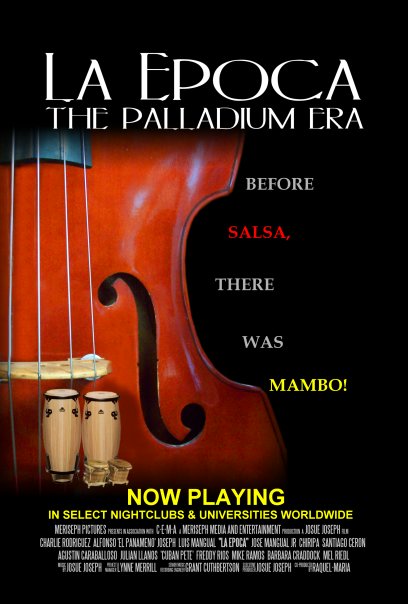New Stuff[hide]
Reportes: From The St... : Cubadisco 2...
Fotos: Tom Ehrlich
Staff: Kristina Lim
Musicos: Juan Formell
Musicos: Yordamis Megret Planes
Musicos: Yasser Morejón Pino
Musicos: José Luis "Changuito" Quintana...
Musicos: Dennis Nicles Cobas
Fotos: Eli Silva
Grupos: Ritmo Oriental : 1988 - Vol. IX - 30 a...
Musicos: Rafael Paseiro Monzón
Musicos: Jiovanni Cofiño Sánchez
Fotos: Tom Ehrlich : 2024 Monterey Jazz, P...
Resenas: Vacilón Santiaguero (Circle 9 ...
Photos of the Day [hide]
La Época, Part I - The Palladium Era (2009) Directed by Josué Joseph
Film Review and Interview: La Época, Part I - The Palladium Era
Meriseph Pictures, 2009, 152 minutes
(Review and interview by Bill Tilford, all rights reserved)
 La Época, The Palladium Era is a tribute film by Josue Joseph about the pre-salsa period of bands and dancers associated with the Palladium Ballroom in New York, the epicenter of what was commonly called the "mambo craze" in the United States from the late 40s to the early 60s.
La Época, The Palladium Era is a tribute film by Josue Joseph about the pre-salsa period of bands and dancers associated with the Palladium Ballroom in New York, the epicenter of what was commonly called the "mambo craze" in the United States from the late 40s to the early 60s.
The Palladium was host to many of the most prominent bands in the US such as Arsenio, Machito, Tito Puente and Tito Rodriguez, and it was a frequent haunt for celebrities as well as a mix of just about everyone else with a serious passion for the music. This writer saw the film at a special viewing at the Alhambra Palace in Chicago on March 29, 2011 and did an interview with the executive producer, Josue Joseph, prior to the screening.
In order to truly appreciate this film's virtues, it is necessary for the viewer to go in with realistic expectations about what the film is and is not. For openers, although the film starts with a brief overview of Cuban musical history, it is not by any means a comprehensive history of Cuban music prior to the 1950s, and since the Mambo was the "star" of the Palladium Era in New York, the opening sequence does not give the same emphasis to the importance of the Son and its earliest pioneers that one would otherwise expect in a full treatment of early Cuban music. It is also not an instructional film about music or dance - the film does succeed in impressing upon the viewer that there was a large variety of rhythms at work in Cuban music prior to the use of the term "Salsa" in the United States, but most of these rhythms are not addressed in depth in this film. We would pause to be critical of this were it not for the fact that a Part II, which we are told is dedicated more specifically to that subject, is in the works. Viewers are also cautioned to remember that this film deals primarily with what happened to the music and dancing after it landed in New York, and that story unfolded differently in many respects than the course of development of the music within Cuba.
One thing that the film does very well is capture the intensity of the enthusiasm of the musicians and dancers of the period through a combination of live interviews and archival footage. The latter tends to focus more on the dancers than the bands, but it was very interesting to see some of the more spectacular dancers of that age such as Cuban Pete in action. It also lays out the case evidence for why Arsenio Rodríguez should be acknowledged as the originator of the Mambo (while mentioning that Cachao should retain credit for composing the first free-standing piece in that rhythm). It also contains extensive discussions of older versus modern dance styles that are likely to provoke debate among some dancers and dance instructors, especially regarding the question of how dancers should relate to the music being played. For those viewers who are unfamiliar with how "Salsa" came to be used commercially as a generic, umbrella term for Cuban and Puerto Rican music in the United States, there are also several good anecdotes related to that subject.
The film works if one takes it on its own terms - a passionate tribute to the Palladium Era, a persuasive argument for why both today's dancers and musicians should learn, preserve and protect many of the 'older' rhythms that were once commonly played here in the US, and an in-depth discussion of how dancing has evolved since the 50s. This writer sees the film as a worthwhile "consciousness-raising" project with a lot of great anecdotes and archival footage.
Prior to watching the film, we had a conversation with the film's executive producer and director, Josue Joseph. Like the film, Josue shared a number of interesting anecdotes in the interview:
Click here for interview!















